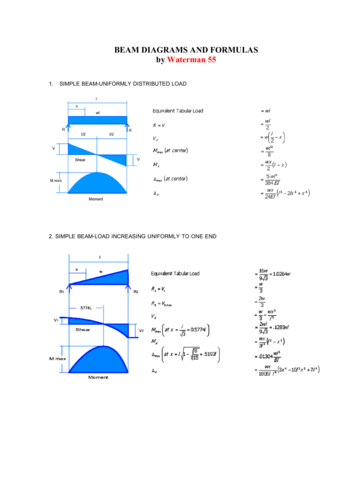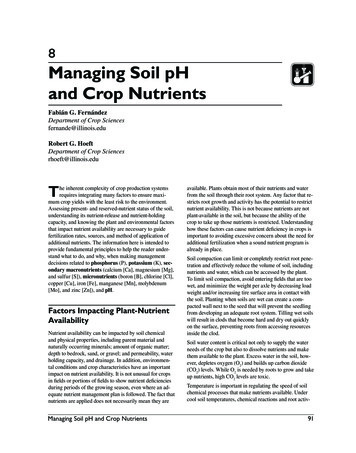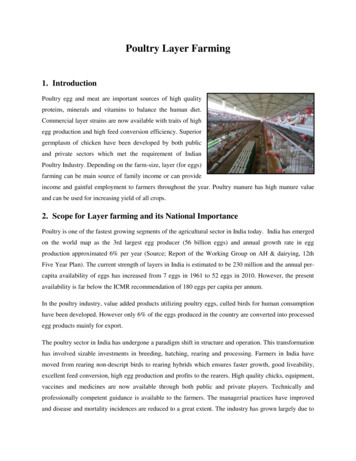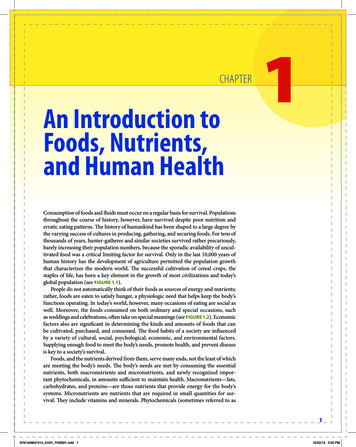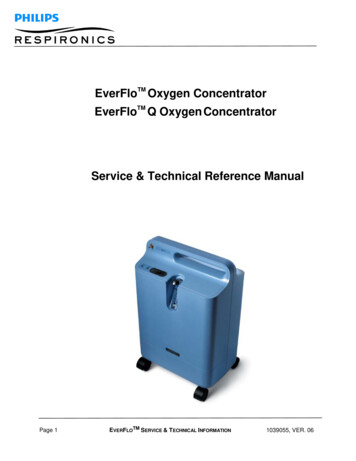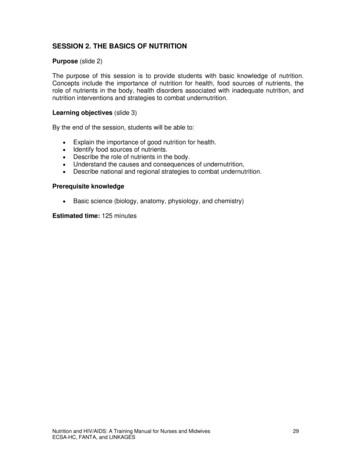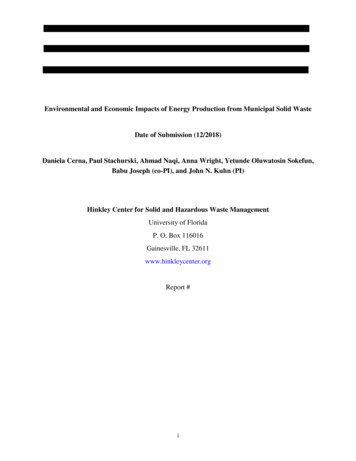
Transcription
Archived PublicationThis information provided in this document is for reference. Please be aware thatthe information in this document may be outdated or superseded by additionalinformation.EPA promulgated regulations for Concentrated Animal Feeding Operations(CAFOs) in February 12, 2003 that expanded the number of operations coveredby the CAFO regulations and included requirements to address the landapplication of manure from CAFOs. The rule became effective on April 14, 2003.NPDES-authorized states were required to modify their programs by February2005 and develop state technical standards for nutrient management. OnFebruary 28, 2005, in response to litigation brought by various organizations, theSecond Circuit court issued its decision in Waterkeeper Alliance et al. v. EPA,399 F.3d 486 (2d Cir. 2005). EPA has updated the CAFO rule to reflect thechanges requested by the Court. Visit www.epa.gov/npdes/caforule to view the2008 CAFO Final Rule and supporting documents.
Managing Manure Nutrients atConcentrated Animal FeedingOperationsDecember 2004
U.S. Environmental Protection AgencyOffice of Water (4303T)1200 Pennsylvania Avenue, NWWashington, DC 20460EPA-821-B-04-009
DisclaimerThis is a guidance manual and is not a regulation. It does not change or substitute for any legalrequirements. While EPA has made every effort to ensure the accuracy of the discussion in thisguidance, the obligations of the regulated community are determined by the relevant statutes,regulations, or other legally binding requirements. This guidance manual is not a rule, is notlegally enforceable, and does not confer legal rights or impose legal obligations upon anymember of the public, EPA, States, or any other agency. In the event of a conflict between thediscussion in this document and any statute or regulation, this document would not becontrolling. The word —should“ as used in this guidance manual does not connote arequirement, but does indicate EPA‘s strongly preferred approach to assure effectiveimplementation of legal requirements. This guidance may not apply in a particular situationbased upon the circumstances, and EPA, States and Tribes retain the discretion to adoptapproaches on a case-by-case basis that differ from this guidance manual where appropriate.Permitting authorities will make each permitting decision on a case-by-case basis and will beguided by the applicable requirements of the CWA and implementing regulations, taking intoaccount comments and information presented at that time by interested persons regarding theappropriateness of applying these recommendations to the particular situation. In addition, EPAmay decide to revise this guidance manual without public notice to reflect changes in EPA‘sapproach to implementing the regulations or to clarify and update text.
Managing Manure at Concentrated Animal Feeding OperationsVersion ControlVersionEPA PublicationNumberPublicationDateDescription of ChangesAuthor’sInitial1EPA-821-B-04-006August 2004Initial ReleasePHS2EPA-821-B-04-009December 2004Revised Appendix H; UpdatedPHSPhosphorus Index
TABLE OF CONTENTSPageCHAPTER 1:A.B.C.D.E.F.G.INTRODUCTION . . . . . . . . . . . . . . . . . . . . . . . . . . . . . . . . . . . . . . . . . . . . . .Purpose of this Document . . . . . . . . . . . . . . . . . . . . . . . . . . . . . . . . . . . . . . . .Scope of this Document . . . . . . . . . . . . . . . . . . . . . . . . . . . . . . . . . . . . . . . . .How To Use this Document . . . . . . . . . . . . . . . . . . . . . . . . . . . . . . . . . . . . . .Other Related Documents . . . . . . . . . . . . . . . . . . . . . . . . . . . . . . . . . . . . . . .Scope of CAFO Regulations . . . . . . . . . . . . . . . . . . . . . . . . . . . . . . . . . . . . . .CAFOs with No Potential to Discharge . . . . . . . . . . . . . . . . . . . . . . . . . . . . . .Comments on Managing Manure . . . . . . . . . . . . . . . . . . . . . . . . . . . . . . . . . .1-11-11-11-11-21-31-41-5CHAPTER 2: OPERATION, MAINTENANCE, AND RECORDKEEPINGREQUIREMENTS FOR THE PRODUCTION AREA . . . . . . . . . . . . . . . . . . . 2-1A.Design Standards . . . . . . . . . . . . . . . . . . . . . . . . . . . . . . . . . . . . . . . . . . . . . . 2-41.Adequate Storage for Manure, Litter, and Process Wastewater . . . . . 2-52.No Discharge for Production Areas . . . . . . . . . . . . . . . . . . . . . . . . . . . 2-8B.Proper Operation and Maintenance . . . . . . . . . . . . . . . . . . . . . . . . . . . . . . . 2-101.Liquid Storage Structures . . . . . . . . . . . . . . . . . . . . . . . . . . . . . . . . . 2-112.Solid Storage Structures . . . . . . . . . . . . . . . . . . . . . . . . . . . . . . . . . . 2-193.Visual Inspections . . . . . . . . . . . . . . . . . . . . . . . . . . . . . . . . . . . . . . . 2-19C.Mortalities, Direct Contact, and Chemical Disposal . . . . . . . . . . . . . . . . . . 2-211.Management of Animal Mortalities . . . . . . . . . . . . . . . . . . . . . . . . . . 2-212.Direct Contact of Animals With Surface Water . . . . . . . . . . . . . . . . . 2-233.Disposal of Chemicals . . . . . . . . . . . . . . . . . . . . . . . . . . . . . . . . . . . . 2-23D.Records . . . . . . . . . . . . . . . . . . . . . . . . . . . . . . . . . . . . . . . . . . . . . . . . . . . . . 2-24E.Additional Voluntary Controls . . . . . . . . . . . . . . . . . . . . . . . . . . . . . . . . . . . . 2-251.Groundwater Protection Controls . . . . . . . . . . . . . . . . . . . . . . . . . . . 2-252.Lagoon Covers . . . . . . . . . . . . . . . . . . . . . . . . . . . . . . . . . . . . . . . . . 2-263.Additional References . . . . . . . . . . . . . . . . . . . . . . . . . . . . . . . . . . . . 2-27CHAPTER 3: PREPARING FOR LAND APPLICATION OF MANURE, LITTER,OR WASTEWATER . . . . . . . . . . . . . . . . . . . . . . . . . . . . . . . . . . . . . . . . . . . .A.Manure Sampling . . . . . . . . . . . . . . . . . . . . . . . . . . . . . . . . . . . . . . . . . . . . . .B.Records . . . . . . . . . . . . . . . . . . . . . . . . . . . . . . . . . . . . . . . . . . . . . . . . . . . . . .C.Additional Voluntary Controls . . . . . . . . . . . . . . . . . . . . . . . . . . . . . . . . . . . . .3-13-13-33-3CHAPTER 4: OPERATION, MAINTENANCE, AND RECORDKEEPINGREQUIREMENTS FOR THE LAND APPLICATION AREA . . . . . . . . . . . . . . 4-1A.Testing Protocols for Manure, Litter, and Soil . . . . . . . . . . . . . . . . . . . . . . . . 4-11.Collecting Manure for Land Application . . . . . . . . . . . . . . . . . . . . . . . 4-22.Manure Sampling and Testing . . . . . . . . . . . . . . . . . . . . . . . . . . . . . . 4-33.Soil Sampling and Testing . . . . . . . . . . . . . . . . . . . . . . . . . . . . . . . . . 4-3B.Protocols to Land Apply Manure . . . . . . . . . . . . . . . . . . . . . . . . . . . . . . . . . . . 4-51.Nutrient Management Plan . . . . . . . . . . . . . . . . . . . . . . . . . . . . . . . . . 4-62.Required Nutrient Management Plan Format . . . . . . . . . . . . . . . . . . . 4-73.Plan Certification . . . . . . . . . . . . . . . . . . . . . . . . . . . . . . . . . . . . . . . . . 4-74.Comprehensive Nutrient Management Plans . . . . . . . . . . . . . . . . . . . 4-75.Crop Rotations and Crop Nutrient Requirements . . . . . . . . . . . . . . . . 4-86.Application Rate . . . . . . . . . . . . . . . . . . . . . . . . . . . . . . . . . . . . . . . . . 4-87.Application Method . . . . . . . . . . . . . . . . . . . . . . . . . . . . . . . . . . . . . . 4-12i
TABLE OF CONTENTSPageC.D.E.8.Application Timing . . . . . . . . . . . . . . . . . . . . . . . . . . . . . . . . . . . . . . .9.Equipment Calibration and Inspection . . . . . . . . . . . . . . . . . . . . . . .10.Additional Land Application Considerations . . . . . . . . . . . . . . . . . . .11.NMP Review and Revision . . . . . . . . . . . . . . . . . . . . . . . . . . . . . . . .Records . . . . . . . . . . . . . . . . . . . . . . . . . . . . . . . . . . . . . . . . . . . . . . . . . . . . .Site-Specific Conservation Practices . . . . . . . . . . . . . . . . . . . . . . . . . . . . . .1.Required Setback or Buffer . . . . . . . . . . . . . . . . . . . . . . . . . . . . . . . .2.Alternatives to Setbacks . . . . . . . . . . . . . . . . . . . . . . . . . . . . . . . . . .Voluntary Conservation and Pollution Prevention Practices . . . . . . . . . . . . .1.Feeding Strategies . . . . . . . . . . . . . . . . . . . . . . . . . . . . . . . . . . . . . .2.Water Conservation . . . . . . . . . . . . . . . . . . . . . . . . . . . . . . . . . . . . ER 5: VOLUNTARY PERFORMANCE STANDARDS FOR CAFOS . . . . . . . . . . . . 5-1A.Overview of the Baseline Requirements . . . . . . . . . . . . . . . . . . . . . . . . . . . . . 5-1B.Overview of the Voluntary Performance Standards Program . . . . . . . . . . . . . 5-21.Program Participation . . . . . . . . . . . . . . . . . . . . . . . . . . . . . . . . . . . . . 5-22.Pollutants of Concern . . . . . . . . . . . . . . . . . . . . . . . . . . . . . . . . . . . . . 5-23.Required Technical Analysis . . . . . . . . . . . . . . . . . . . . . . . . . . . . . . . . 5-34.Validation of Equivalent Pollutant Reductions . . . . . . . . . . . . . . . . . . . 5-35.Relationship to Existing NPDES Permits . . . . . . . . . . . . . . . . . . . . . . 5-4C.Step-By-Step Requirements for Participation in the Voluntary PerformanceStandards Program . . . . . . . . . . . . . . . . . . . . . . . . . . . . . . . . . . . . . . . . . . . . . 5-41.Determining Baseline Pollutant Discharge . . . . . . . . . . . . . . . . . . . . . 5-42.Demonstrating That an Alternative Control Technology AchievesEquivalent or Better Pollutant Reductions . . . . . . . . . . . . . . . . . . . . . . 5-63.Obtaining an Alternative Performance Standard . . . . . . . . . . . . . . . . . 5-74.Future Case Studies . . . . . . . . . . . . . . . . . . . . . . . . . . . . . . . . . . . . . 5-21CHAPTER 6: DEVELOPING AND USING TECHNICAL STANDARDS FOR THELAND APPLICATION OF MANURE, LITTER, AND PROCESSWASTEWATER . . . . . . . . . . . . . . . . . . . . . . . . . . . . . . . . . . . . . . . . . . . . . . . 6-1A.Developing Technical Standards for Land Application . . . . . . . . . . . . . . . . . . 6-11.EPA Recommended Technical Standards and Policies . . . . . . . . . . . 6-12.Factors for Developing Technical Standards . . . . . . . . . . . . . . . . . . . 6-43.NRCS Standards and NMPs . . . . . . . . . . . . . . . . . . . . . . . . . . . . . . . . 6-44.Example National Nutrient Management Technical Standards forLand Application . . . . . . . . . . . . . . . . . . . . . . . . . . . . . . . . . . . . . . . . . 6-55.Appropriate Flexibility in Applying Technical Standards . . . . . . . . . . . 6-5B.Example Rate Calculations . . . . . . . . . . . . . . . . . . . . . . . . . . . . . . . . . . . . . . . 6-61.Manure Production and Composition . . . . . . . . . . . . . . . . . . . . . . . . . 6-62.Developing a Nutrient Budget . . . . . . . . . . . . . . . . . . . . . . . . . . . . . . . 6-83.Land Application Rate Calculation . . . . . . . . . . . . . . . . . . . . . . . . . . 6-11C.Manure Management Planner . . . . . . . . . . . . . . . . . . . . . . . . . . . . . . . . . . . 6-12CHAPTER 7: AVOIDING COMMON DEFICIENCIES . . . . . . . . . . . . . . . . . . . . . . . . . . . . . .A.Proactive Management . . . . . . . . . . . . . . . . . . . . . . . . . . . . . . . . . . . . . . . . .B.Common Deficiencies . . . . . . . . . . . . . . . . . . . . . . . . . . . . . . . . . . . . . . . . . . .1.Inadequacy of Storage Capacity . . . . . . . . . . . . . . . . . . . . . . . . . . . . .ii7-17-17-27-2
TABLE OF CONTENTSPage2.3.4.5.6.7.8.9.Infrequent Dewatering of Storage Structures . . . . . . . . . . . . . . . . . . .Pumpdown Practices . . . . . . . . . . . . . . . . . . . . . . . . . . . . . . . . . . . . .Lagoon Agitation . . . . . . . . . . . . . . . . . . . . . . . . . . . . . . . . . . . . . . . . .Representative Manure Samples . . . . . . . . . . . . . . . . . . . . . . . . . . . .Animal Mortality Practices . . . . . . . . . . . . . . . . . . . . . . . . . . . . . . . . . .Chemical Handling . . . . . . . . . . . . . . . . . . . . . . . . . . . . . . . . . . . . . . .Emergency Action Plans . . . . . . . . . . . . . . . . . . . . . . . . . . . . . . . . . . .Example Onsite Check List . . . . . . . . . . . . . . . . . . . . . . . . . . . . . . . . .7-27-27-27-37-37-37-47-5CHAPTER 8: ADDITIONAL RESOURCES . . . . . . . . . . . . . . . . . . . . . . . . . . . . . . . . . . . . . .A.USDA Funding Programs for CAFOs . . . . . . . . . . . . . . . . . . . . . . . . . . . . . . .B.USDA and EPA Livestock and Poultry Environmental StewardshipCurriculum . . . . . . . . . . . . . . . . . . . . . . . . . . . . . . . . . . . . . . . . . . . . . . . . . . . .C.EPA Programs and Information . . . . . . . . . . . . . . . . . . . . . . . . . . . . . . . . . . .D.USDA Programs and Information . . . . . . . . . . . . . . . . . . . . . . . . . . . . . . . . . .E.Associations and Trade Groups . . . . . . . . . . . . . . . . . . . . . . . . . . . . . . . . . . .8-18-18-28-28-48-5Appendix A - EFFLUENT LIMITATIONS GUIDELINES AND STANDARDS FORCONCENTRATED ANIMAL FEEDING OPERATIONSAppendix B - INSPECTION CHECKLIST FOR A LARGE CAFOAppendix C - RECORDKEEPING CHECKLIST FOR THE PRODUCTION AREA AND LANDAPPLICATION AREA AT A LARGE CAFOAppendix D - MEASURING THE AMOUNT OF ANIMAL WASTEAppendix E - ANIMAL WASTE SAMPLINGAppendix F - SOIL SAMPLING AND TESTINGAppendix G - LEACHING INDEXAppendix H - PHOSPHORUS INDEXAppendix I -AGRONOMIC NUTRIENT APPLICATION RATEAppendix J - CALIBRATING ANIMAL WASTE SPREADERS AND IRRIGATORSAppendix K - SOIL LOSS (EROSION)Appendix L - WINTER SPREADING TECHNICAL GUIDANCEAppendix M - MINIMUM DEPTH OF RAIN AT WHICH RUNOFF BEGINSAppendix N - RECOMMENDED BEST MANAGEMENT PRACTICES (BMPS) ANDCONSERVATION PRACTICE STANDARDSiii
TABLE OF CONTENTSPageAppendix O - EXAMPLE NATIONAL NUTRIENT MANAGEMENT TECHNICAL STANDARDAppendix P - CALCULATIONS FOR ESTIMATING MEDIAN ANNUAL OVERFLOWVOLUMES AND ANNUAL AVERAGE DISCHARGE OF POLLUTANTSiv
LIST OF TABLES5-1Summary Description of Baseline Requirements . . . . . . . . . . . . . . . . . . . . . . . . . . . . 5-2LIST OF FIGURES1-1Example CAFO Potentially Demonstrating No Potential to Discharge . . . . . . . . . . . . 1-52-1Production Area at Whole Milk Dairy . . . . . . . . . . . . . . . . . . . . . . . . . . . . . . . . . . . . . 2-32-2Cross Section of Properly Designed Lagoon . . . . . . . . . . . . . . . . . . . . . . . . . . . . . . 2-142-3Schematic of Lagoon Depth Marker . . . . . . . . . . . . . . . . . . . . . . . . . . . . . . . . . . . . . 2-17v
CHAPTER 1:A.B.C.D.E.F.G.INTRODUCTION . . . . . . . . . . . . . . . . . . . . . . . . . . . . . . . . . . . . . . . . . . . . . . .Purpose of this Document . . . . . . . . . . . . . . . . . . . . . . . . . . . . . . . . . . . . . . . .Scope of this Document . . . . . . . . . . . . . . . . . . . . . . . . . . . . . . . . . . . . . . . . .How To Use this Document . . . . . . . . . . . . . . . . . . . . . . . . . . . . . . . . . . . . . .Other Related Documents . . . . . . . . . . . . . . . . . . . . . . . . . . . . . . . . . . . . . . .Scope of CAFO Regulations . . . . . . . . . . . . . . . . . . . . . . . . . . . . . . . . . . . . . .CAFOs with No Potential to Discharge . . . . . . . . . . . . . . . . . . . . . . . . . . . . . .Comments on Managing Manure . . . . . . . . . . . . . . . . . . . . . . . . . . . . . . . . . .1-11-11-11-11-21-31-41-5Figures1-1Example CAFO Potentially Demonstrating No Potential to Discharge . . . . . . . . . . . . 1-5
Chapter 1: IntroductionCHAPTER 1: INTRODUCTIONA.Purpose of this DocumentIn early 2003, EPA issued significant revisions to its regulations for NPDES permitting ofconcentrated animal feeding operations (“CAFOs”) under the Clean Water Act. In December,2003, EPA issued a guidance document for CAFO permitting titled “NPDES Permit Writers’Guidance Manual and Example NPDES Permit for Concentrated Animal Feeding Operations,”EPA-833-B-04-001 (“Permit Guidance”). That guidance document discussed the generalframework for NPDES permitting of CAFOs under the Clean Water Act and EPA’s revisedregulations. It addressed such issues as when does an animal feeding operation becomedefined as a CAFO, when are CAFOs required to get a permit, the difference between generalpermits and individual permits, and what effluent limitations and standards should or must beincluded in NPDES permits for CAFOs.This document, “Managing Manure,” is designed to supplement EPA’s previousguidance by providing additional technical information to owners, operators, technical serviceproviders, consultants, and permit authorities on how to carry out EPA’s revised regulatoryrequirements for NPDES permitting of CAFOs. It also provides information on voluntarytechnologies and management practices that may both improve the production efficiency ofCAFOs and further protect the quality of the nation’s waters. This document assumes thatreaders have a basic understanding of the CAFO regulations.B.Scope of this DocumentEPA’s regulations governing CAFOs consist primarily of two different sets of regulations.First, the regulations at 40 CFR 122.23 set the framework for CAFO permitting by establishingcriteria for who is defined as a CAFO and specifying whether, and when, a CAFO must apply fora permit. The second set of regulations, which are at 40 CFR Part 412, are the effluentlimitations guidelines and standards (“ELGs” or “effluent guidelines”) for CAFOs, which establishdischarge limits and certain management practice requirements that must be included inNPDES permits for CAFOs.While the regulations at 40 CFR 122.23 apply to all operations, it should be noted thatthe ELG requirements in 40 CFR Part 412 apply only to permitting of Large CAFOs, as that termis defined in the regulations. The statements below on what is required under the ELGstherefore apply only to the permitting of Large CAFOs. For permitting of Medium and SmallCAFOs, permitting authorities will set effluent limitations on a case-by-case basis based on sitespecific conditions. Where deemed appropriate by the permitting authority, the permittingauthority may set effluent limitations for those CAFOs that are similar to the ELG requirementsfor Large CAFOs. EPA encourages permitting authorities to consider the discussions below onthe requirements and recommendations for applying the ELG to Large CAFOs whenestablishing permit conditions for CAFOs of any size.C.How To Use this DocumentManaging Manure contains information pertinent to Large CAFOs in the Dairy Cows andCattle other than Veal Calves and the Swine, Poultry, and Veal Calves subcategories of thefinal CAFO regulations (see Section E of this chapter). Permit writers, at their discretion on acase-by-case basis, may want to consider the information in this manual pertinent to small andmedium CAFOs. The effluent guidelines requirements cited in this manual must be included inpermits for Large CAFOs, while the permit writer may include them in permits for smallerCAFOs at the permit authority’s discretion. This manual assumes readers have a basicunderstanding of the CAFO regulations. Text boxes in each section provide the relevantregulatory language, additional clarifications, and examples for key concepts.1-1
Chapter 1: IntroductionManaging Manure is organized into eight chapters and 15 appendices:CChapter 2 identifies and discusses the production area requirements of theCAFO rules, example technologies that may help a facility comply with theproduction area requirements, and additional voluntary practices that may benefitoperators of many Large CAFOs.CChapter 3 identifies the requirements prior to land application of manure, litter,and process wastewater (i.e., manure sampling and recordkeeping if thesewastes are transferred off site).CChapter 4 describes the land application area requirements of the CAFO rules(including the Nutrient Management Plan, setback requirements, andrecordkeeping) example management practices that may be used to help complywith the land application area requirements, and additional voluntary practicesthat may benefit operators of most Large CAFOs.CChapter 5 describes the goals and requirements of the voluntary alternativeperformance standards for CAFOs, including several detailed case studies thatmay help CAFOs and Permit Authorities develop their own voluntary alternativeperformance standards.CChapter 6 provides guidance and case studies for the development and use ofTechnical Standards for land application.CChapter 7 describes the most common deficiencies found at CAFOs, identifiespractices to help avoid them, and includes some case studies of managementpractices CAFOs may use to help achieve compliance with the CAFOregulations.CChapter 8 lists resources for additional help in complying with the regulations.This document also includes several appendices including the regulations foundat 40 CFR, sample inspection checklists, records checklist, sample calculations,and example methods for manure sampling, and equipment calibration. Theseexamples are not binding or required, they are examples of how some PermitAuthorities have implemented the regulatoryrequirements.CTo further assist the user of this document, text boxes ineach section provide the relevant regulatory language,additional clarifications, and examples for key concepts.Regulatory citations are provided in text boxes with adouble line. Examples and clarifications are denoted bytext boxes with a single line.D.Other Related DocumentsThe Producer’s Guide (Producers’ ComplianceGuide for CAFOs, EPA, 2003) gives a generaldescription of the revised CAFO regulations and helpsan animal feeding operation (AFO) determine whetherthey might be regulated under the revised regulations.The Permit Guidance (Permit Writers GuidanceManual and Sample NPDES Permit for ConcentratedAnimal Feeding Operations, EPA, 2003) providesinformation to NPDES permit writers on the permitting1-2
Chapter 1: Introductionrequirements for CAFOs. This Permit Guidance is accompanied by a series of questions andanswers that reiterate the regulatory requirements and provide additional clarity by referring tocorresponding sections of the CAFO final preamble.Because they do not describe in detail the full set of federal regulatory requirements forCAFOs or the pertinent State requirements, neither the Producer’s Guide nor the PermitGuidance are intended to be used to ensure that a CAFO is in compliance with all applicablerequirements. Readers are further cautioned that any of these guidance documents may berevised or amended without notice.EPA’s National Agriculture Compliance Assistance Center(http://www.epa.gov/agriculture/) provides information on environmental requirements affectingthe agriculture industry, including links to resources and publications. This web site iscontinually updated.Chapter 8 of this document provides additional resources.E.Scope of CAFO RegulationsThe federal regulatory requirements for CAFOs consist of Effluent Limitation Guidelinesand Standards for the CAFOs point source category (40 CFR Part 412), and NPDES permittingrequirements for CAFOs (40 CFR Part 122). In 2003, EPA revised both the effluent guidelinesand NPDES permitting requirements for CAFOs. Among other things, the new regulationsestablish manure management performance standards for new and existing CAFOs. AnyNPDES permit issued to a CAFO after April 14, 2003 must contain the revised effluentguidelines at 40 CFR Part 412. Appendix A of this document contains a copy of these finalrules. CAFOs should read these federal regulations as well as any state regulations for CAFOs,and should check with the agency that regulates CAFOs in that state to determine permittingrequirements. For more information on EPA’s regulatory authority for the CAFO regulations,see Section 1 of the Final CAFO Preamble and Chapter 1 of the Development Document for theFinal Revisions to the NPDES and the Effluent Guidelines for Concentrated Animal FeedingOperations, available at www.epa.gov/npdes/caforule .The NPDES permitting regulationsgenerally define an AFO, among other things,as an operation where livestock or poultry areconfined for an extended period of time (see40 CFR 122.23 (b)(1) for the legal definition).This definition is intended to differentiateconfinement-based operations from pasturebased operations, where the latter areintended to be excluded from the CAFOregulations.AFO Definition§122.23 (b)(1) Lot or facility (other than anaquatic animal production facility) where animals(other than aquatic animals) have been, are, orwill be stabled or confined and fed or maintainedfor a total of 45 days or more in any 12-monthperiod:ANDWhere crops, vegetation, forage growth, or postharvest residues are not sustained in the normalgrowing season over any portion of the lot orfacility.An operation is a Large CAFO if itmeets the definition of an AFO and it confinesat least:CCCCCCCCC700 mature dairy cows;1,000 beef cattle or heifers;1,000 veal calves;2,500 swine (each 55 pounds or more);10,000 swine (each under 55 pounds);30,000 chickens (liquid manure handling systems);125,000 chickens except laying hens (other than liquid manure handlingsystems);82,000 laying hens (other than liquid manure handling systems);55,000 turkeys;1-3
Chapter 1: IntroductionCCCC5,000 ducks (liquid manure handling systems);30,000 ducks (other than liquid manure handling systems);500 horses; or10,000 sheep or lambs.The CAFO regulations also use the terminology“Medium CAFOs” and “Small CAFOs;” these terms aregenerally not used in this document. For more informationon the definition of a CAFO, consult the Permit Guidanceas well as Chapter 2 of the Development Document for theFinal Revisions to the National Pollutant DischargeElimination System Regulation and the Effluent Guidelinesfor Concentrated Animal Feeding Operations. Both ofthese documents can be found on the Internet at www.epa.gov/npdes/caforule .The effluent guidelines referred to in this documentvary depending on whether the CAFO is currentlyoperating at the time that the regulations were revised or ifconstruction of the operation began after April 14, 2003.Newly constructed CAFOs, and certain CAFOs expandingthe size of their operation may be subject to more stringentrequirements known as New Source PerformanceStandards (NSPS). For more information consult thePermit Guidance as well as the guidance memorandumentitled "New Source Determinations for Direct and IndirectDischargers" and 2004 memorandum entitled “ClarificationRegarding CAFOs in 10-Year Protection Period.”The effluent guidelines are broken into the following subparts, each addressing specificanimal sectors:CCCCSubpart A:Subpart B:Subpart C:Subpart D:Horses and Sheep;Ducks;Dairy Cows and Cattle other than Veal Calves; andSwine, Poultry, and Veal Calves.Managing Manure focuses only on the animal operations with new or revised effluentguidelines, specifically Subparts C and D (beef cattle, dairy cattle, veal calves, swine, chickens,and turkeys). Though the effluent guidelines for horses, sheep, and ducks have not changed,these facilities may be subject to revised or additional requirements under the revised NPDESpermitting requirements for CAFOs at 40 CFR Part 122. Even for AFOs that are not regulatedas CAFOs, EPA encourages all owners and operators of those AFOs to review the practicesdescribed in this guidance manual and consider adopting those practices that are applicable totheir operation.F.CAFOs with No Potential to DischargeThe NPDES CAFO regulations require all CAFOs to apply for a permit. EPA recognizesthat, although they may be infrequent, there may instances where a CAFO truly does not have apotential to discharge. Therefore, an exception is that in lieu of a permit application, LargeCAFOs can request a “no potential to discharge” determination from the permitting authoritywhere there is no potential for any CAFO manure, litter, or process wastewater to be added towaters of the United States under any circumstances or climatic condition. If the permittingauthority makes a determination that the CAFO has “no potential to discharge”, the operationwould not need to apply for an NPDES permit. Land application discharges from a CAFO aresubject to NPDES requirements. It is important to note that the “no potential to discharge”determination applies to both the production area and land application areas under the control1-4
Chapter 1: Introductionof the CAFO. The “no potential to discharge” determination process may include a site visit toverify the information submitted by the CAFO operator or to gather additional informationnecessary to make the determination. See Figure 1-1 for an example CAFO that might be ableto make a demonstration of no potential to discharge.For more information on supporting a request for a “no potential to discharge”determination, see section 3.3.5 of the Permit Guidance, available on the internet athttp://www.epa.gov/npdes/pubs/cafo permit guidance chapters.pdfFigure 1-1. Example CAFO Potentially Demonstrating No Potential to DischargeG.Comments on Managing ManureThis document may be revised or amended periodically without public notice. EPAwelcomes public comments on this document at any time, and will consider those comments inany future revision of this document. Comments, including additional helpful information, maybe submitted electronically to Paul Shriner at shriner.paul@epa.gov, or mailed to:U.S. EPAEngineering and Analysis Division 4303T1200 Pennsylvania Avenue, N.W.Washington, D.C. 204601-5
CHAPTER 2: OPERATION, MAINTENANCE, AND RECORDKEEPING REQUIREMENTS FOR THE PRODUCTION AREA . . . . . . . . . . . . . . . . . . . . . . . . . . . . . . . . . . . . . . . . . . . . . 2-1 A.Design Standards . . . . . . . . . . . . . . . . . . . . . . . . . . . . . . . . . . . . . . . .
soil sampling and testing leaching index phosphorus index agronomic nutrient application rate calibrating animal waste spreaders and irrigators soil loss (erosion) winter spreading technical guidance minimum depth of rain at which runoff begins appendix n - recommended best management
